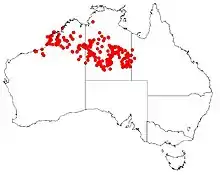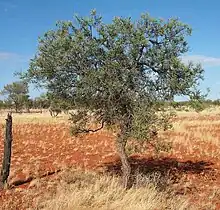Hakea macrocarpa
Hakea macrocarpa, commonly known as dogwood hakea,[2] is a shrub or tree in the family Proteaceae. It has cream-yellow flowers from May to June. It is native to Western Australia and the Northern Territory.
| Dogwood hakea | |
|---|---|
 | |
| Scientific classification | |
| Kingdom: | Plantae |
| Clade: | Tracheophytes |
| Clade: | Angiosperms |
| Clade: | Eudicots |
| Order: | Proteales |
| Family: | Proteaceae |
| Genus: | Hakea |
| Species: | H. macrocarpa |
| Binomial name | |
| Hakea macrocarpa | |
 | |
| Occurrence data from AVH | |

Description
The erect slender tall shrub or tree typically grows to a height of 1 to 6 metres (3 to 20 ft).[3] The trunk and branches have black-brown furrowed bark and it is able to resprout from the base. Branchlets are covered in fine matted hair. The leaf petiole is 1 to 5 millimetres (0.039 to 0.197 in) in length and the narrowly linear thick lamina is 5 to 35 centimetres (2 to 14 in) in length and 3 to 15 mm (0.118 to 0.591 in) wide.[4] It blooms from May to October and produces cream-green-yellow flowers.[3] Each inflorescence is composed of 40 to 200 cream-yellow flowers with a perianth that is 7 to 15 mm (0.275590551 to 0.590551181 in) long. The pistil has a length of 18 to 30 mm (0.71 to 1.18 in) with a straight or curved style and an oblique pollen presenter. After flowering fruit form with a curved beak that are 22 to 40 mm (0.87 to 1.57 in) in length containing seeds that are 18 to 37 mm (0.71 to 1.46 in) long and 9 to 14 mm (0.354 to 0.551 in) wide with a wing down over half of one side.[4]
Taxonomy
The species was first formally described by the botanist Robert Brown as published in the work Proteaceas Novas. Supplementum primum prodromi florae Novae Hollandiae. The recognised synonyms are Grevillea alphonsiana published by Ferdinand von Mueller and Hakea morrisoniana, described as a new species by William Vincent Fitzgerald in 1918, the epithet commemorating Alexander Morrison.[5][2] The specific epithet is derived from the ancient Greek words makros (μακρός) meaning "long" and karpos (καρπός) meaning "fruit".[6]
Distribution
It is endemic to an area in the central Northern Territory and the Kimberley, Pilbara and Goldfields-Esperance region of Western Australia where it has a scattered distribution. The plant is commonly found among coastal sand dunes, on sandplains and on and around rocky ridges where it grows in red sandy soils.[3]
References
- "Hakea macrocarpa". Australian Plant Census. Retrieved 11 December 2019.
- "Hakea macrocarpa A.Cunn. ex R.Br. Dogwood Hakea". Atlas of Living Australia. Global Biodiversity Information Facility. Retrieved 18 June 2016.
- "Hakea macrocarpa". FloraBase. Western Australian Government Department of Biodiversity, Conservation and Attractions.
- "Hakea macrocarpa". Electronic Flora of South Australia. Government of South Australia. Retrieved 27 October 2018.
- Fitzgerald, William Vincent; Maiden, Joseph (1918). The botany of the Kimberleys, Northwest Australia. Perth: W. Simpson, Govt. Printer. pp. 33–4.
- Backer, C.A. (1936). Verklarend woordenboek der wetenschappelijke namen van de in Nederland en Nederlandsch-Indië in het wild groeiende en in tuinen en parken gekweekte varens en hoogere planten (Edition Nicoline van der Sijs).